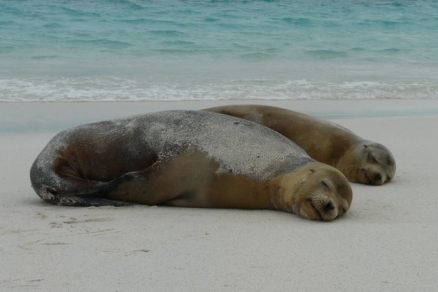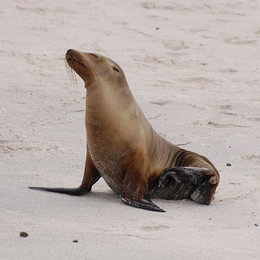Galapagos sea lion
The Galápagos sea lion (Scientific name: Zalophus wollebaeki) is one of 16 species of marine mammals in the family of Eared seals which include sea lions and fur seals. Together with the families of true seals and Walruses, Eared seals form the group of marine mammals known as pinnipeds.
Eared seals differ from the true seals in having small external earflaps and hind flippers that can be turned to face forwards. Together with strong front flippers, this gives them extra mobility on land and an adult fur seal can move extremely fast across the beach if it has to. They also use their front flippers for swimming, whereas true seals use their hind flippers.
The Galápagos sea lion is found in the Galápagos Archipelago where it is one of the most conspicuous and numerous marine mammals.
|
Conservation Status |
|
Scientific Classification Kingdom: Anamalia (Animals) |
Contents
Physical Description
Adult males are much larger than females and are brown in colour while females are a lighter tan. Adult males are also distinguished by their raised foreheads, and the hair on the crest may be a lighter colour. Juvenile Galápagos sea lions are chestnut brown in colour and measure around 75 cm at birth.
Reproduction
Each colony is dominated by one bull that aggressively defends his territory from invading bachelor males. This territorial activity occurs throughout the year and males hold their territories for only 27 days or so before being displaced by another male. Within this territory the bull has dominance over a group of between 5 and 25 cows.
The breeding season is not dependent on migration patterns, as seen in other sea lion species, since the Galápagos sea lion remains around the Galápagos Archipelago all year round. In fact the breeding season is thought to vary from year to year in its onset and duration, though it usually lasts 16 to 40 weeks between June and December. Births therefore also take place throughout the year, with females coming ashore to give birth to a single pup.
Within two to three weeks of giving birth females go into oestrous again and actively solicit a male. Gestation lasts around 11 months, though it probably includes a three month period in which implantation of the fertilized egg is delayed while the female nurses her young.
Behavior
The Galápagos sea lion is essentially a coastal animal and is rarely found more than 16 kilometres out to sea. Individuals are active during the day and hunt in relatively shallow waters (up to about 200 metres deep) where they feed on fish, octopus, and crustaceans. Sea lions and seals are also capable of making extraordinarily deep dives of up to 200 metres for 20 minutes or more, then rapidly surfacing with no ill effects. When ashore, the Galápagos sea lions rest on sandy beaches and rocky areas in colonies of about 30 individuals. They are extremely gregarious and pack together on the shore even when space is available.
Like other sea lions this species relies on cooperation within the group. Often, a single adult female will watch over a group of young pups while other mothers are fishing. They are careful to keep the young pups out of deep water where they may be eaten by sharks. The bull will also watch out for his "family" by warning them of the presence of a nearby shark with barks, and even occasionally chasing away the intruder.
Distribution
This sea lion is found on islands in the Galápagos Archipelago and off the coast of Ecuador where a population has been introduced.
Habitat
On land this sea lion prefers sandy or rocky flat beaches where there is vegetation for shade, tide pools to keep cool and good access to calm waters. It also spends much of its time in the cool, fish-rich waters that surround the Galápagos Islands
Conservation Status
The Galápagos sea lion is currently classified as Endangered on the IUCN Red List (IUCN Red List Criteria for Critically Endangered)
The Galápagos sea lion occurs in one of the most biologically diverse areas of the world. The Galápagos Islands have long been studied and protected and were influential in the formulation of Darwin's theory of evolution by natural selection. Most recently, in March 1998, a 133,000 km2 area was designated as the Galápagos Marine Reserve, making it one of the world's largest protected areas. Detailed conservation and research programmes have been developed, which focus on studying the islands' ecology, the effects of environmental fluctuations on species and the effects of humans on wildlife. These measures have to some extent protected this sea lion, especially from hunting.
The Charles Darwin Research Centre has implemented an ecological monitoring project of the Galápagos sea-lion to determine the state and abundance of the sea lions. This project also studies the ongoing threats to this mammal and has developed simple rescue methods for injured or caught sea lions. Elsewhere in the world, sea lions are suffering dramatic population declines for unknown reasons, and so conservation measures like these, which both monitor and protect the sea lion, are invaluable in the future of the Galápagos sea lion
Threats
The Galápagos sea lion faces various threats. In the 19th century, sea-lions worldwide were hunted for their meat, skin and oil. The hunting of some sea-lions, including the Galápagos species, has now been banned and populations have recovered. Galápagos sea lions are still vulnerable to human activity as their inquisitive and social nature means they are more likely to approach areas inhabited by humans. This brings them into contact with fishing nets, hooks and human waste, all of which can be fatal. There are also problems resulting from the increase in numbers of deep-water tuna and billfish fisheries as these sea-lions become victims of by-catch. Research indicates that the majority of these incidents (67%) involve juveniles, probably due to their more curious and playful nature.
These marine mammals are also negatively affected by the phenomenon El Niño. During El Nino 1997 and 1998, Galápagos sea lion populations of the main colonies declined by 48 percent. Many sea lions migrated and, amongst those that stayed in the Galápagos Archipelago, there was high mortality due to starvation. A viral disease, known as sea lion pox, is another threat to this marine mammal. The illness is spread by mosquitoes and causes paralysis, which in turn prevents the sea lion from feeding and may result in death.
Further Reading
- wollebaeki Sivertsen, 1953 Encyclopedia of Life (accessed April 8, 2009)
- Zalophus, Seal Conservation Society (accessed April 8, 2009)
- The Pinnipeds: Seals, Sea Lions, and Walruses, Marianne Riedman, University of California Press, 1991 ISBN: 0520064984
- Encyclopedia of Marine Mammals, Bernd Wursig, Academic Press, 2002 ISBN: 0125513402
- Marine Mammal Research: Conservation beyond Crisis, edited by John E. Reynolds III, William F. Perrin, Randall R. Reeves, Suzanne Montgomery and Timothy J. Ragen, Johns Hopkins University Press, 2005 ISBN: 0801882559
- IUCN Red List (January, 2008)
- Heath, C.B. (2002) California, Galapagos, and Japanese sea lions. In: Perrin, W.F., Wursig, B. and Thewissen, J.G.M. Eds. Encyclopedia of Marine Mammals. Academic Press, San Diego.
- Walker's Mammals of the World, Ronald M. Nowak, Johns Hopkins University Press, 1999 ISBN: 0801857899
- [1], MarineBio.org (accessed, April 8, 2009)
- Galápagos and Californian sea lions are separate species: Genetic analysis of the genus Zalophus and its implications for conservation management, Wolf, JB; Tautz, D; Trillmich, F, Frontiers in zoology,2007.


